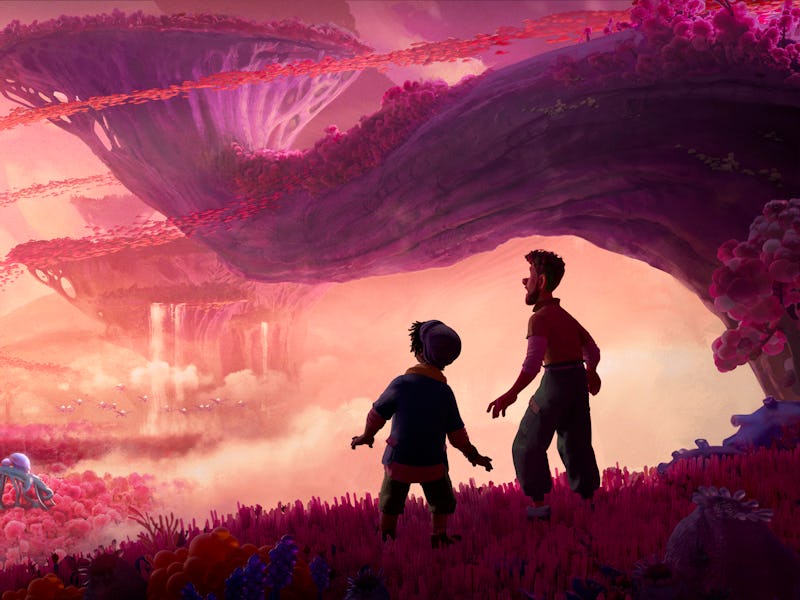Strange World delivers pulp adventure with a popcorn movie sensibility
More like not-so-strange world.

Disney’s greatest talent has always been the ability to remix classic stories for each new generation. The House of Mouse built its foundations on fairytale musicals plucked from the public domain, but over the years it expanded into fantasy adventures, folk tales, and animal-led riffs on Shakespeare. Though a few original contemporary movies are sprinkled in there, pastiche is Disney’s bread and butter.
So when Disney discovers a whole new genre to play with, there’s cause for celebration. Especially when it’s a genre as weird and wild as pulp adventure.
Strange World, the new Disney animated film directed by Don Hall (Raya and the Last Dragon) and written and co-directed by Qui Nguyen (also Raya and the Last Dragon), borrows liberally from early 20th-century stories like Doc Savage and retro sci-fi action films like Journey to the Center of the Earth and King Kong. The film is pure pulp adventure both in style and sentiment — following a family of adventurers who traverse a dangerous, brightly colored, alien world that looks like a cross between Candyland and Pandora. But Strange World carries with it a thoroughly modern attitude that could prevent it from joining the ranks of Disney’s timeless classics.
Strange World is an adventure for the whole family — and your dog too.
Strange World takes us immediately to Avalonia, a land lifted directly from a 1930s bande dessinée comic populated by horse-drawn carriages and early 20th century-clad peoples. An old-timey newsreel introduces the legendary explorer Jaeger Clade (Dennis Quaid) and his son Searcher (Jake Gyllenhaal) as they brave dangerous terrain and looming mountains to search for a new home for their people. But Searcher doesn’t share his father’s dauntless attitude, preferring instead to look to the Earth instead of the distant horizon. When Searcher discovers a natural resource that could become a power source for the people of Avalonia, the rift between father and son grows into a gaping chasm. Jaeger heads off on his own to find that horizon, and Searcher returns to Avalonia to farm the new resource, called Pando.
Twenty-five years later, and Avalonia has rapidly industrialized thanks to Searcher’s discovery of Pando. The horse-drawn buggies have been replaced by cars, huge spacecrafts now crowd the skies, and Searcher is a happy family man and profitable farmer of Pando. But something has gone wrong — all the Pando crops are withering, and their energy quickly depletes. So Searcher is enlisted by Avalonia President Callisto Mal (Lucy Liu) for an expedition to the heart of Pando, leading him and his family, including wayward teen son Ethan (Jaboukie Young-White) who stows away on the ship, into a strange, brightly colored land deep beneath the surface of the world.
In this strange world, every creature is friend-shaped.
Disney and pulp adventure seem like strange bedfellows. One is known as the pinnacle of family-friendly storytelling. The other is, well, the opposite. Everything lurid, sordid... (all the id’s) are associated with the ghastly and tasteless pulp literature of the early 1900s, which got its name from the cheap wood pulp paper it was published on. Pulp heroes may have eventually birthed the modern superhero, but they were far from family-friendly literature. So just the prospect of seeing Disney’s take on pulp adventure is a tantalizing premise. Does Strange World live up to that premise? Yes and no.
From the moment the first images were released for Strange World, it was undeniable the film had the look of a pulp adventure. The world it presented was candy-colored, wild, and dazzling. Amoeba-shaped monsters and bubblegum dinosaurs populated this pink and purple land, which seemed both fatal and friendly to its human explorers. Wordless blue blobs became the movie’s cute sidekick. In those visuals alone, Strange World manages to capture the spirit of pulp adventure: the idea that anything could happen, and that things could get even weirder. Disney pulls further inspirations from Christopher Nolan’s Interstellar, James Cameron’s Avatar, and, strangely enough, Osmosis Jones, to mix things up even more. As a pastiche, Strange World is a success. But as a movie on its own, it leaves a little to be desired.
“You’re giving up your dream!” “No dad, I’m giving up your dream!”
When you boil it down, Strange World is a father-son movie. And it’s the most typical father-son conflict you can get on the big screen: “Son, you’re giving up your dream.” “No dad, I’m giving up yours!” And while Gyllenhaal and Quaid are more than enthusiastic enough to play out this father-son angst, it feels a little too tired even in a Disney movie built on pastiche. Jaboukie Young-White is a breath of fresh air as Searcher’s son Ethan (the LGBTQ character whose existence is kicking up a storm with angry conservatives), who similarly wants to pursue his own dream over his farmer dad’s humble aspirations. But, perhaps in an attempt to freshen up these age-old story beats, Strange World layers in a few too many hip anachronisms (avocado toast, a Settlers of Catan-type card game, fun teen slang!) that the film starts to feel creaky in its own way.
By the time Strange World comes around to its true message of saving the earth from climate change, the shine has already begun to fade. The novelty of Disney exploring a pulp adventure genre can only go so far when it tells the same old story.
Strange World is out in theaters on November 23.
This article was originally published on